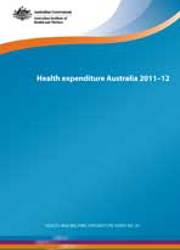Summary
This report provides estimates of health expenditure in Australia between 2001–02 and 2011–12. Expenditure was estimated to be $140.2 billion in 2011–12, up in real terms (after adjustment for inflation) from $82.9 billion in 2001–02 and $132.6 billion in 2010–11.
In 2011–12, health expenditure as a percentage of gross domestic product (GDP) was 9.5%, up from 8.4% in 2001–02. Much of the increase coincided with the Global Financial Crisis. From 2001–02 to 2007–08, the ratio of health expenditure to GDP increased by 0.4 percentage points from 8.4% to 8.8%. In just the following two years, the ratio increased by 0.6 percentage points to 9.4% in 2009–10.
The ratio of government health expenditure to taxation revenue was relatively stable between 2001–02 and 2007–08, increasing from 19.9% to 20.8%. It then rose to a peak in 2009–10 of 26.2% and declined to 25.6% in 2011–12. Over the decade to 2011–12, the Australian Government ratio of health expenditure to taxation revenue rose by 4.0 percentage points to 26.4%, while the state and territory governments ratio rose by 8.1 percentage points to 24.5%.
Analysis of health inflation suggests that the annual increase in prices in the broader economy in recent years has generally been faster than increases in prices in the health sector. Growth in health expenditure, has largely been driven by increases in the volume of health goods and services purchased, rather than price.
In 2011–12, the estimated national average level of recurrent expenditure on health was $5,881 per person. Expenditure varied from $5,711 per person in New South Wales to $8,512 per person in the Northern Territory.
Governments funded 69.7% of total health expenditure during 2011–12, an increase from 69.1% in 2010–11. The percentage contribution of the Australian Government fluctuated throughout the decade, dropping from 44.0% in 2001–02 to 42.4% in 2011–12. The state and territory contribution grew steadily from 23.2% to 27.3% over the same period. Non-government sources funded 30.3% in 2011–12, down from 32.8% in 2001–02.
Spending on public hospital services in 2011–12 was estimated at $42.0 billion, or 31.8% of recurrent expenditure. Expenditure on medical services ($23.9 billion, or 18.1%) and medications ($18.8 billion, or 14.2%) were other major contributors. Increased spending on public hospital services of $2.1 billion in real terms was the largest component of the increase in health expenditure since 2010–11, accounting for approximately one-third (32.9%) of the increase in recurrent expenditure. This was followed by spending on medical services, which grew by $1.0 billion in real terms.
The Australian Government's share of public hospital services funding was 38.2% in 2011–12, down from 39.6% in 2010–11. State and territory governments' share was 53.3% in 2011–12, up from 52.0% in 2010–11 and 47.2% in 2001–02.
Based on the Organisation for Economic Co-operation and Development (OECD) System of Health Accounts framework, Australia's health expenditure to GDP ratio in 2011 (9.1%) was just above the OECD median (9.0%). Australia's average health expenditure per person in 2011 ($5,952) was also higher than the OECD average ($5,484) and median ($4,851).
Preliminary material: Acknowledgments; Abbreviations; Symbols
1 Introduction
- What is health expenditure?
- The structure of the health sector and its flow of funds
- Structure of this report
- Changes to Australian Institute of Health and Welfare estimates
- Revisions to Australian Bureau of Statistics estimates
2 Health expenditure
- Total health expenditure
- Health expenditure and the GDP
- Government health expenditure and tax revenue
- Health expenditure per person
- Recurrent health expenditure
- International comparisons
3 Funding of health expenditure
- Broad trends
- Capital expenditure
- Australian Government funding
- State and territory, and local governments
- Non-government funding
- Individuals
4 Data quality statement
- Summary of key issues
- Description
- Institutional environment
- Timeliness
- Accessibility
- Interpretability
- Relevance
- Accuracy
- Coherence
5 Technical notes
- Definition of health expenditure
- Data and methods used to produce estimates
- Non-government
- Blank cells in expenditure tables
Appendixes
Appendix tables
Appendix A: National health expenditure matrixes
Appendix B: State and territory health expenditure matrixes, 2009-10 to 2011-12
Appendix C: Price indexes and deflation
Appendix D: Population
End matter: Glossary; References; List of tables; List of figures; List of boxes; Related publications



